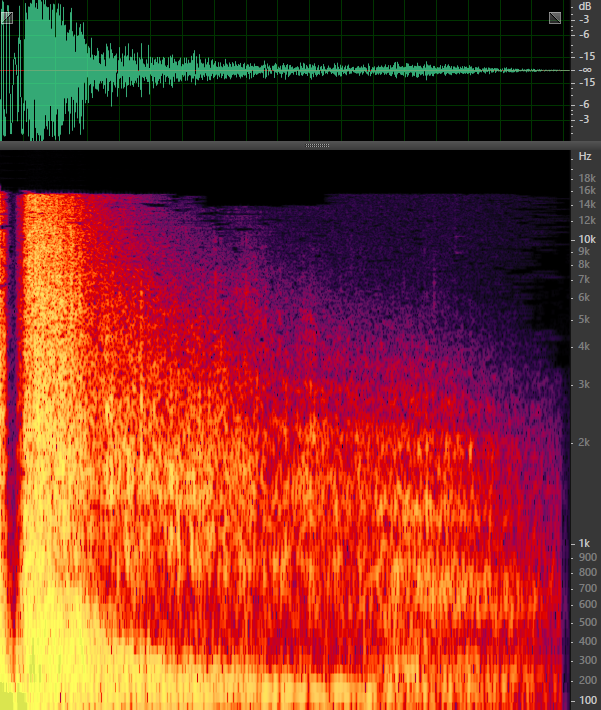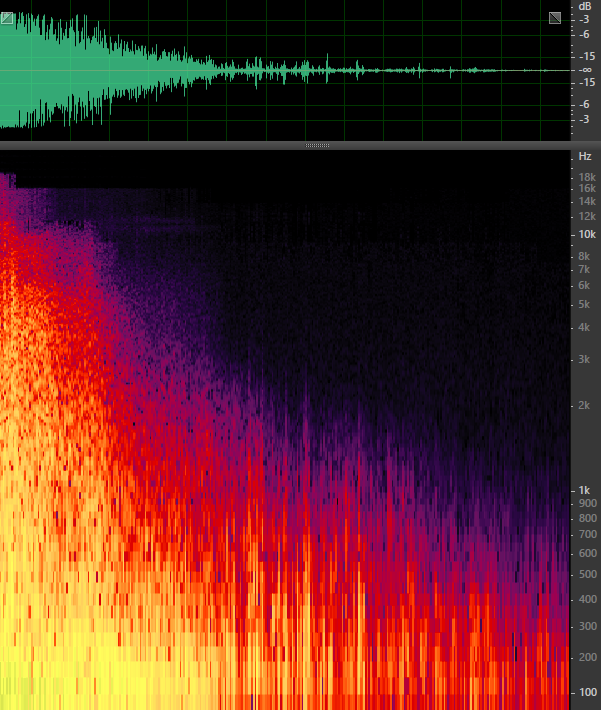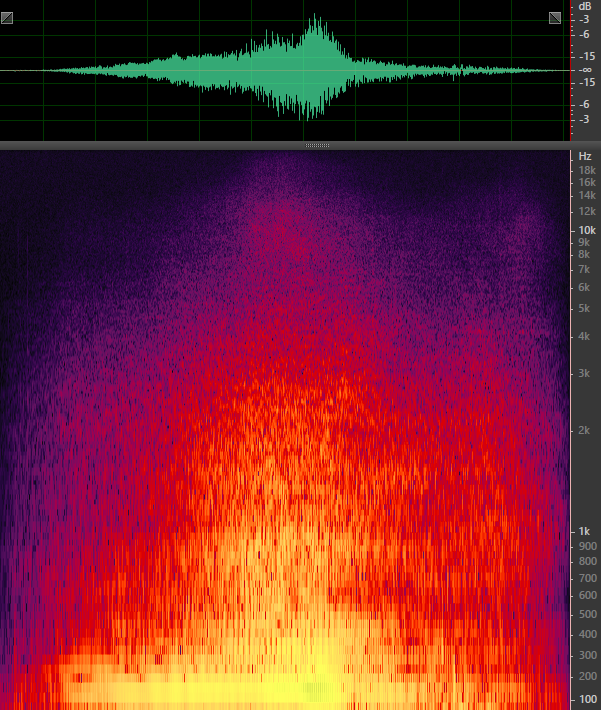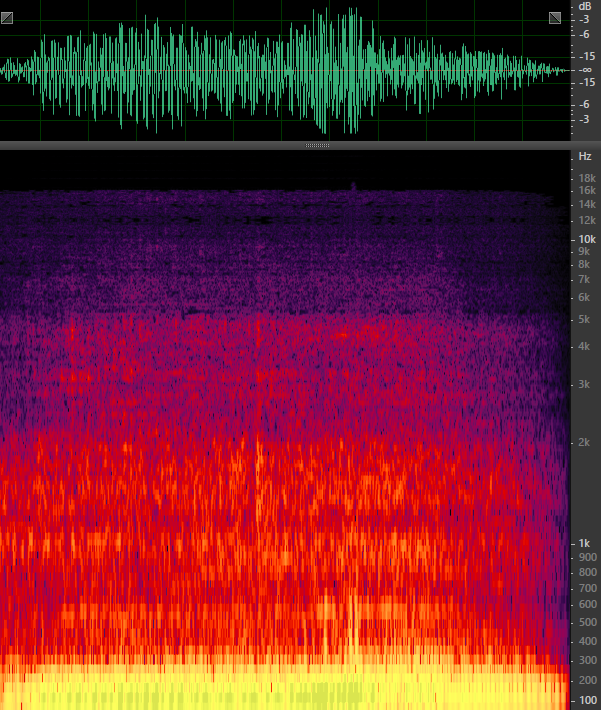Legacy Headset Benchmarking Methodology
Typical Vehicle & Combat Sounds
Weapon noises are very complex. In addition to the initial concussion, there are also air and flight noises, along with potential reflections. There is no such thing as the weapons sound, as every make and model sounds different.
Shotgun, Single Shot
The sound is broadband and voluminous, and it requires the entire frequency spectrum for good reproduction. In addition to the total noise pattern, this sound also has very characteristic peaks for individual frequencies.
Explosions
The sound of exploding C4 is entirely different, and closer to fading pink noise after its high initial level.
Tank Gun, Single Shot
The sound produced by the main gun of an approaching tank is relatively close to the sound of a C4 explosion. Spatial location is difficult to ascertain, as the stereo spectrum clearly shows.
But whereas the brighter sound of an explosion occupies a range of up to 20 kHz, the tank gun, with its spectral range up to 12 kHz, sounds more dull and voluminous.
Sniper Rifle, Single Shot
This noise is based on two acoustic events: the broadband muzzle blast with a peak at about 500 Hz, and flight/air noises with a peak at about 2.5 kHz. If this sound is played on equipment lacking ample response in the 400-600 Hz range, or if it cuts out around 3 kHz, the muzzle blast is drowned out and the result comes out closer to the sound of a handgun.
Handgun (9mm), Single Shot
This brighter-sounding handgun has a wide spectrum that almost looks like white noise. Any sound design would noticeably alter the weapon's character. Even minor modifications through an equalizer could degrade the gun to sound like a smaller-caliber weapon (treble boost), or make it sound like a big, fat .45 (exaggerated upper bass and lower mid-range).
Get Tom's Hardware's best news and in-depth reviews, straight to your inbox.
Automatic Weapons, (Long Volleys In A Confined Space)
As our next graphic shows, a longer volley of fire ~20° to the left creates an issue for spatial recognition, since the staccato-like muzzle blasts completely overlap the reflections that would have otherwise helped to identify the source. Instead, we get a single mess of loud noise.
Games that allow you to easily locate the source of such a volley, even in small, enclosed spaces, are unrealistic. They're almost assuredly the product of manipulated sound.
Automatic Weapons, (Three Short Bursts Outdoors)
What happens outdoors when reflections are taken away? The concussion of a machine gun volley occupies the whole spectrum fairly evenly. Up to ~6 kHz, even the noises after the initial explosion are still linear. Except for the first muzzle blast, not much happens below ~350 Hz. Too-high of a bass boost up to the upper-bass range could turn these volleys into heavy cannon shots, so again, manipulating the sound isn't advised.
Whether you're talking about firearms or explosives, nothing is more broadband than a bang! Sound manipulation does little more than distort the perception of these events, making it harder to identify the type of weapon being fired. And it definitely doesn't help with spatial orientation. Exaggerated bass furthermore destroys every link to reality, leaving a messy, dull impression. Too much weight on high frequencies has the opposite effect, making the battlefield sound cluttered with small-caliber weapons.
Passing Truck
Engine and tire noises make for a relatively broadband composition with an emphasis on bass. Higher frequencies are important as well, though. They contain the tires' rolling noise. Without them, every road surface quickly turns into an arid sand dune.
Passing Tracked Vehicle (Tank)
In contrast to the rather dull-sounding truck, this makes for a more interesting profile. In addition to the engine noise, the tank's tracks challenge playback hardware with a complex noise pattern. In this scenario, different frequency ranges are used intensively. Good reproduction of all details is thus highly important.
Passing Jet Airplane
It's easy to imagine the Doppler effect in play while looking at this recording of a jet fly-by. Engine and air noises blend together, creating an interesting range of frequencies.
Stationary Hovering Helicopter
The most dominant sounds we hear with a helicopter hovering overhead are broadband and high-frequency rotor/air noises. The engine adds bass-heavy background noise.
Complex Situation: Battlefield With Machine Gun Fire, Detonations & Tracked Vehicles
Looks like a mess of noise, right? But when this source material is fed to low- and high-quality headsets separately, the difference is an eye-opener, particularly if you're accustomed to inexpensive hardware and the muddy sounds those cheaper products generate.
Only the best speakers (with good level stability) are able to cope well with such a complex accumulation of acoustic events. Good identification and location of individual sound sources are the crown of headphone playback, and this depends solely on driver quality. Without the right substructure, all of Dolby's technology means very little.
Complex Situation: Battlefield With Passing Squadron Of Planes
In this scenario, characterized by several jets flying by, only the best headphones are good enough for our tastes.
Complex acoustic environments require perfect resolution, detailed reproduction of the frequency spectrum, and high-level stability. Any headset attempting to modify the individual frequency ranges makes it more difficult to properly locate these rather broadband sound sources.
MORE: Best Deals
Current page: Typical Vehicle & Combat Sounds
Prev Page Human Language, Animals & Movement Next Page How We Measure & Compare
Igor Wallossek wrote a wide variety of hardware articles for Tom's Hardware, with a strong focus on technical analysis and in-depth reviews. His contributions have spanned a broad spectrum of PC components, including GPUs, CPUs, workstations, and PC builds. His insightful articles provide readers with detailed knowledge to make informed decisions in the ever-evolving tech landscape
-
the nerd 389 In the article, you say that headphones always create the perception that the source is right at the head. This is incorrect. Newer techniques use either binaural recordings or HRTF approximations to reproduce entire auditory spaces.Reply
When employed correctly, these techniques allow for a more accurate reproduction of an environment than is possible with speakers.
If surround headphones employ those techniques, the result is true 3D sound (two angles, as well as distance). That said, the technology needed to pull this off in real time is still a few years away. For now, binaural recordings are the only way to achieve this effect in practice.
Finally, you should probably disclose the output impedance of your sources. Many headphones have drastically different frequency and phase response between low impedance and high impedance sources. The effect is most pronounced with low impedance headphones, like most gaming headsets (<64 ohms). Motherboards and sound cards usually have a high output impedance (10-100 ohms), while decent headphones amps have low impedance (<2 ohms). -
Spanky Deluxe I just don’t get Tom’s Hardware sometimes. They go out of their way to make top quality articles with great testing methodologies but at the same time make the website absolute garbage to use with half the stuff covered in abnoxious adverts, a terrible UI experience and then even more adverts for even worse stuff that is blatantly obviously scam sites like “How local <ISP LOCATION AREA> housewife earns $15962 per month from home” and the like. Sometimes adverts even stop you reading an article on mobile, i.e. actually block you pressing the next page button. I hardly ever read articles anymore here despite being a visitor for about 20 years as it’s just too much hard work to wade through the website design and adverts everywhere.Reply -
icycool_q1 Completely agree Spanky, I am coming here less and less because of the huge video playing throughout almost every article. In addition to that, I have very poor internet and it takes considerable time for this crap to even load. Hell, I'd be happy to pay them $5/year just to have NONE of this extraneous rubbish.Reply -
Co BIY Tom's reviews headsets?Reply
No category under peripherals ? and I don't remember a recent review. -
FormatC This is the intro review to understand, what we test and how. The headset reviews will follow soon. I'm testing headsets for the German site since a few years (my latest). I think, it is a good compromise for the masses to get more info and to understand, what we write. Not too flat like an unboxing video on YT and and not too in-dept like for the golden ears. ;)Reply
Finally, you should probably disclose the output impedance of your sources.
If measure with an good external amp, not on an onboard output. But with exception of a few pilot headsets I wasn't able to find a gaming headset above 32 ohms.
Newer techniques use either binaural recordings or HRTF approximations to reproduce entire auditory spaces.
As I wrote in the review, all this techniques are using your brain (and experience) to produce this immersion. But it doesn't help to make a bad headset better or to hear "more". ;)
-
hannibal I agree the article. I have always have good Hi-Fi speakers and headphones. Many years back I did Also buy Gaming headset (expensive one) and used it a while and was deeply dissapointed by the sound quality. Did go back to old music Hi-Fi headphones and was much more pleased and the next time I did upgrade my music system I did by the best Hi-Fi music headphones that I could afford at that moment and have been really pleased the sound quality.Reply
Good bass even in low volume, good balance at low volume, same when you increase the volume upp. So balanced and straight linear sound in all situations!
The multidriver system is interesting, but very difficult to make right. Have to check out some uber models From Senheiser and othe big audio manufacturers to see how well They can do it with their best systems. -
the nerd 389 @FormatCReply
I didn't mean to imply that you should measure with a low impedance source. Quite the contrary, actually. Most people don't have headphone amps, so it doesn't make sense to measure with one if that's your audience. All I meant was that the output impedance has a substantial impact on how headphones measure, so it's worth disclosing. It only takes a few minutes to measure if you have a decent multimeter and a couple of resistors lying around.
Your Creative unit should have an impedance between 10 and 50 ohms. That's a big enough range that it's a pretty notable amount of uncertainty in any measurements you do with it, though. It's worth mentioning that of the units I've measured, I've found almost no difference in output impedance between onboard audio and gaming-oriented sound cards. Even the external ones usually have at least 10 ohms of impedance.
Regarding the binaural and HRTF techniques, it's not really fair to say that they use the brain/experience to produce the effect. They simulate a physical phenomenon that occurs when sound hits the outer ear and head. You can even measure the effect (assuming you can sit still long enough).
The wording you chose is akin to saying "the lights in your room allow you to see using your brain/experience to allow you to perceive objects." Again, it's not technically incorrect, but it's not really going to help anyone understand it any better. Also, I wouldn't mention it except for the fact that the HRTF is likely going to become a major factor in mainstream audio in the next few years. It's already used in some high-end audio solutions, and it's expected to be a major ingredient in the next phase of VR. -
FormatC I'm building audio systems since 1979 and I followed in the past each trend to understand (or very often not), what the industry and their PR tried to sell us. I'm visiting a lot of meetings and workshops and it is every time very interesting to hear, what scientists, engineers and medicals said. Alone the inner structure of a human ear is so complex, that we can found thousands of variances of a different spatial immersion. For one person this fakes are working well, for others not. Or simply different. I also saw a lot of blind tests and the results were every time within the statistic. A good 50:50 for stereo vs. artificial sound manipulations.Reply
What I would say with this small story is:
Never believe, what the industry said. This is (mostly) pure PR and the utilization of the term Gaming, only to sell their low-end more expensive, is pure nonsense. Stickers and audio labels are nonsense too. Money makers. Good audio hardware can cost a lot of money but our job must it be in the first row, to find the the better pieces between all this crap. What we will do is a thing in the middle of this mostly senseless unboxing YT videos and the Hi-Fi magazines. Call it science for the masses. But we have in each case to take care, that we will stay understandable for all readers. Not so easy... ;)
BTW: The Creative amp is running between 10 ohms and 600 ohms not bad. But I'm trying each headset also onboard (if it is not USB) to see, how it performs. I'm worked together with MSI for example to improve their mainboard audio solutions and a lot of other companies have now a bigger focus at the audio part of their mainboard design (components, positioning). This was also a follow of my investigations of all this VGA-related influences ("you can hear what you see") and the mainboard layout. The fact, that you can see now on a lot of VGA cards low pass filters for all rails is a direct follow of this work. Together with improved PSUs... ;) -
JonDol Reply20524062 said:... it’s just too much hard work to wade through the website design and adverts everywhere.
There are already long years since AdBlockers became mandatory on THW in order to have a pleasant reading experience. Don't wait anymore before installing a few (not only one since some of them have agreements with ad networks and sneakily whitelist some ads to let them reach you). I personally have at least 3 AdBlockers on every web browser I use.
-
Virtual_Singularity Reply20524205 said:Completely agree Spanky, I am coming here less and less because of the huge video playing throughout almost every article. In addition to that, I have very poor internet and it takes considerable time for this crap to even load. Hell, I'd be happy to pay them $5/year just to have NONE of this extraneous rubbish.
Hmmm... Totally, agree. Save for the $5 a year part. =P
Edit: Good article all the same, as it's an area Tom's hasn't breached much, at least yet, as far as I've seen (or heard). Like the contributor with the outstanding DL/UL speed in the sig hints at: "not too flat like an unboxing video, and not too in depth like for the golden ears". I like that description. Though I personally wouldn't mind a "golden ears" type of review. But then, that'd likely remove or disqualify most gaming headsets from the topic altogether, along with readers? Though just so Tom's knows, some of us would indeed take the time to read the in-depth, "golden ears" stuff. I grew up in the analog world and usually still prefer it, maybe. Ha.












